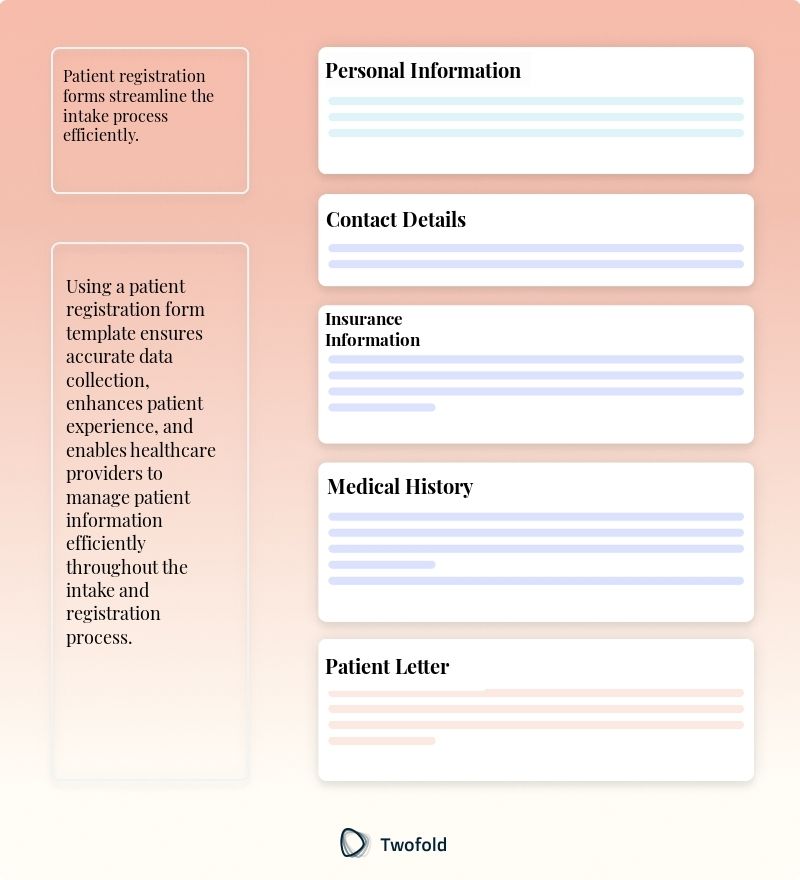
Patient Registration Form Template
Whether you're a healthcare professional, office manager, or a patient trying to understand healthcare processes, you've probably come across the concept of patient registration forms. These documents can often seem daunting, but they are essential for ensuring that a patient's journey through the healthcare system is smooth and effective. Let's break down the patient registration form template and explore why it's so crucial.
What Is a Patient Registration Form Template?
A patient registration form template is a standardized document used to collect essential information from new patients at a healthcare facility. This form typically gathers personal details, contact information, medical history, and insurance information.
The use of templates helps healthcare providers ensure that they collect uniform data for all patients, simplifying the process of record‑keeping and enabling better patient management.
Key Components of a Patient Registration Form
There are several critical components that should be included in a patient registration form to ensure comprehensive data collection:
- Patient's full name
- Date of birth
- Contact information (address, phone number, email)
- Emergency contact details
- Insurance information
- Medical history (including allergies and medications)
- Consent for treatment and privacy notice acknowledgment

How to Use a Patient Registration Form Template: Step-by-Step Process
- Download the patient registration form template from a reliable healthcare resource.
- Customize the template to fit the specific needs of your practice.
- Distribute the form to new patients upon their arrival.
- Instruct patients on how to fill out the form and provide assistance if needed.
- Collect completed forms and input the data into your patient management system.
- Store the forms securely in compliance with privacy regulations.
Benefits of a Patient Registration Form
Benefit | Description |
|---|---|
Streamlined Data Collection | Standardizing patient information helps in quick and efficient data gathering. |
Improved Patient Experience | A well-structured form can enhance patient satisfaction by making registration easy. |
Regulatory Compliance | Forms that meet legal standards help avoid potential legal issues for the practice. |
Data Consistency | Using a template ensures uniformity in the information collected across patients. |
Efficient Communication | Clearly gathering contact information facilitates easier follow-ups and communication. |
Stakeholders in Patient Registration Forms
The patient registration form involves several key stakeholders in the healthcare process:
- Healthcare Providers: Doctors and nurses rely on accurate patient data for treatment decisions. For example, a physician may review medical histories before prescribing medications.
- Administrative Staff: Office staff manage the forms and ensure data entry into systems, making their processes quicker and more organized.
- Patients: Patients provide the necessary information, affecting their care experience. A patient who fills out a registration form correctly can receive timely care and services.
- Insurance Companies: They depend on accurate information for billing and reimbursement processes, ensuring that healthcare facilities are compensated correctly.
Example of a Patient Registration Form
Here is a basic example of what a patient registration form might include:
- Patient Name: __________________________
- Date of Birth: __________________________
- Address: ________________________________
- Phone Number: __________________________
- Insurance Provider: ______________________
Real-World Use Cases: Practical Impact of the Patient Registration Form Template
Understanding the real‑world impact can illustrate how effective these templates can be.
- Busy Urban Clinic: at a bustling clinic, a well-designed registration form significantly reduced waiting times, enabling staff to process new patients in under 15 minutes.
- Accessibility in remote areas: in a rural hospital, the use of mobile registration forms helped gather data from patients in remote areas, making healthcare more accessible.
- Quality Care in Speciality Medicine: A specialized healthcare provider noted an increase in patient accuracy, allowed them to review backgrounds before visits, ultimately enhancing patient care.
Conclusion
In summary, patient registration forms play a vital role in enhancing patient experience and operational efficiency within healthcare settings. By adopting a well‑designed template, healthcare facilities can streamline data collection, ensure compliance, and improve communication with patients. Keeping these forms updated and ensuring proper completion will lead to higher satisfaction and optimized care delivery.
Disclaimer: This article is for informational purposes only and does not constitute legal or medical advice. Always consult professional guidelines and regulatory bodies for specific compliance requirements.

Dr. Danni Steimberg
Dr. Danni Steimberg is a pediatrician at Schneider Children’s Medical Center with extensive experience in patient care, medical education, and healthcare innovation. He earned his MD from Semmelweis University and has worked at Kaplan Medical Center and Sheba Medical Center.
A well‑structured Patient Registration Form does more than collect basic details—it streamlines intake, enhances billing accuracy, and ensures compliance. A thoughtful design reduces errors, speeds up onboarding, and supports seamless insurance processing.
- Standardize Required Fields: Use clear, structured sections for demographics, insurance details, and medical history. Avoid open-ended questions for critical data—drop-down menus and checkboxes reduce errors and speed up form completion.
- Align with Billing & Compliance: Ensure that ICD-10 and CPT-related fields (e.g., referring provider, primary diagnosis) are captured upfront. Missing or inconsistent data can lead to claim denials, delays, or compliance issues.
- Incorporate Digital Efficiency: Use e-signatures, auto-fill options, and secure online submission to streamline processing. A well-integrated system not only improves patient experience but also enhances administrative efficiency, reducing staff workload.
Frequently Asked Questions
Reduce burnout,
improve patient care.
Join thousands of clinicians already using AI to become more efficient.

Urgent Care Note Template
Discover practical Urgent Care Note templates to enhance your documentation efficiency.

Mental Health Doctors Note Template
Discover practical Mental Health Doctors Note templates to enhance your documentation efficiency.

Mental Health Risk Assessment Template
Discover practical Mental Health Risk Assessment templates to enhance your documentation efficiency.


